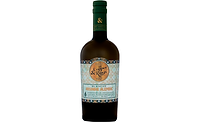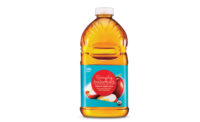Secondary beverage packaging just as significant as primary, experts note
Retail-ready secondary packaging attracts consumers, drives sales

Beverage packaging companies work to provide a cleanshelf appearance and optimized pack counts so that products consistently stand up within the display tray, Aaron Donlon says. (Image courtesy of Delkor Systems)
In a world where packaging facilitates so much more than just functionality, it is important for brand owners to take their products’ secondary packaging as seriously as its primary packaging. As Jill Lahman from Douglas Machine Inc. notes, “Secondary packaging is the last thing on your mind, but the first thing your customer sees.”
Not only does secondary packaging protect the primary packaging and the products contained within, but it markets the brand and attracts attention in-store through colorful retail displays, the Alexandria, Minn.-based company says. Secondary packaging reinforces brands, as well as enhances product visibility in a crowded marketplace, it adds.
Experts agree that secondary packaging has as much an impact on the beverage market as primary packaging does. David Hayslette, director of business development for craft beverages at Richmond, Va.-based WestRock, explains that secondary packaging can drive consumer perceptions while impacting the manufacturing environment for beverage companies.
Another expert, Aaron Donlon, product manager at Delkor Systems, St. Paul, Minn., says that the rapid adoption of retail-ready packaging [also called shelf-ready packaging], has had a tremendous impact on the beverage market. Major retailers, like Walmart and Kroger have adopted and improved their operations to meet this trend.
“For retailers, this shift has translated into more efficient in-store operations, improved product shelf displays, higher shipping efficiencies by utilizing smaller cases, and quicker ‘buy’ decisions from consumers,” he continues.
“Retail-ready packaging designs have enabled secondary packaging to better interface with the customer when they are shopping by enabling beverage manufacturers to brand the display tray and provide important information such as flavor varieties,” Donlon adds. “The branded display trays can pull the customer in and attract them to a product.”
Retail-ready packages also are vital for retail operations. “Retail-ready packages are stable during shipping and easy to stock, with features such as an easy-tear feature to remove the case hood or shrink-wrap to help boost in-store operations to drive up efficiency of the retailer,” Donlon explains.
Strategic advantage
Brand owners are utilizing secondary packaging to elevate their brands and help them stand out on ever-crowded shelves. “Brands are using secondary packaging to differentiate their products on the shelf by employing alternative structures, print enhancements and configurations,” WestRock’s Haylette says. “Further, brands use specialized packaging to improve the perception of their products by switching from less impactful multi-packing solutions.” Because of retail-ready packaging’s in-store prominence, brand owners can differentiate their product on the retail shelf by branding and designing the display trays, often with less materials, Delkor’s Donlon notes.
“Those who are moving faster towards the new formats are also set apart on-shelf with cleaner looking displays and fewer ‘out-of-stock’ scenarios as some major retailers have a more aggressive shelf restocking arrangement for products that are in shelf-ready packaging,” he explains.
“In addition to shelf-ready, some brand owners are leveraging the latest digital printing technology on their corrugated board shippers and shelf displays,” Donlon continues. “While this is still an emerging technology in North America, the number of suppliers with this capability has grown significantly in the last 12 months. Digital printing allows for very high quality, customized, targeted promotional printing for different markets or locations without the burden of needing to purchase expensive print plates to traditional printing methods.”
Beverage brands continuously have to adapt their capabilities to meet consumer trends. “Improved and evolved retail-ready package designs are spearheading advancements in secondary packaging,” Donlon says. “Retailers are asking for single-facing or very narrow displays for the shelf — displays that would transport very poorly on a pallet. Delkor’s Turbo Case (patented, U.S. and International) was designed to solve that challenge by combining two or more display trays with a single top pad and shrink film into a single-wrapped unit for shipping.
“The minimal materials that are used in each Delkor Turbo Case are recyclable,” he continues. “Compared to traditional retail-ready packaging, the minimized material usage helps to significantly cut packaging costs, while enabling brand owners to palletize more product per pallet while improving pallet stability,” he says.
WestRock’s Hayslette notes that improvements in the manufacturing of the substrate itself have improved the strength and durability of the packaging. “Digital printing has reduced the minimum order quantities for many packaging formats and provided the ability for brands to specialize their packaging,” he says.
To aid in customer service, Delkor Systems streamlines its design, engineering and implementation of secondary packaging needs from the package design itself to palletizing, Donlon says. “Delkor works closely with major retailers to understand emerging retail-ready packaging trends, and both the display and structural requirements.
“Delkor’s in-house package lab offers 48-hour turn-around on samples that meet retailer structural, labeling and sizing requirements and can seamlessly run on our automated packaging equipment lines,” he adds.
“In addition to our package lab, our two most popular retail-ready formats are widely adopted at major retailers. The Delkor Cabrio Case and the Delkor Turbo Case are distributed throughout North America with over 200 million cases per year flowing through distribution centers and onto store shelves,” he says.
Secondary solutions
Ssecondary packaging and retail-ready packaging go hand-in-hand, Donlon says. “The initial rush to implement retail-ready packaging was in response to aggressive deadlines set by retailers to implement these designs into their shelves,” he says.
“The tight deadlines meant that many brand owners had to rush decisions and make compromises to their case designs which resulted in inconsistent performance for many package designs. Retailers have had issues with packaging perforations, opening mechanics, display tray appearance, distribution instability and improper sizing/facings,” he adds.
The next wave of retail-ready packaging, sometimes referred to as “Retail-Ready 2.0,” will involve retailers working with their suppliers to fix peformance issues while improving packaging design and performance. For example, making the packaging easier to open, providing a clean shelf-appearance, and optimizing pack counts so that products consistently stand up within the display tray, Donlon says.
In the future, WestRock’s Hayslette sees continued growth and insights-based innovative designs for secondary packaging. “We continue to listen and learn from all levels of brand owners (manufacturing, sales and marketing) to understand what their unmet needs are and how we can apply secondary packaging solutions to address these needs,” he says.
WestRock also is developing sustainable, paper-based solutions to better meet the needs of brand owners. “From the small brand that has previously only had plastic-based multi-package solutions to hand packaged cartons to automated solutions, we are able to support brands at any stage in their growth,” Hayslette says. ”Our goal is to partner with them when they are small and participate and help drive their growth.” BI
Looking for a reprint of this article?
From high-res PDFs to custom plaques, order your copy today!







